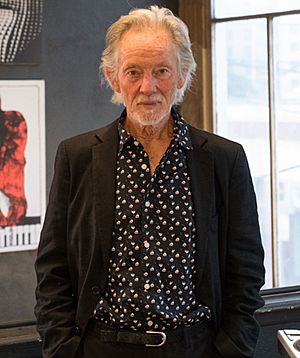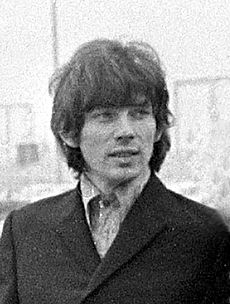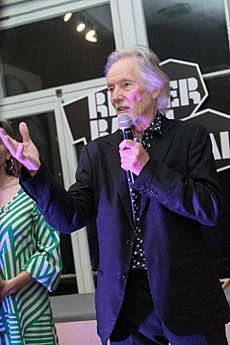Klaus Voormann facts for kids
Quick facts for kids
Klaus Voormann
|
|
|---|---|

Voormann in 2018
|
|
| Background information | |
| Born | 29 April 1938 Berlin, German Reich |
| Origin | Hamburg, West Germany |
| Genres | |
| Occupation(s) |
|
| Instruments |
|
| Years active | 1960–present |
| Labels |
|
Klaus Otto Wilhelm Voormann (born 29 April 1938) is a German artist, musician, and record producer. He is well-known for his work in music and art.
Klaus Voormann played bass guitar for the band Manfred Mann from 1966 to 1969. He also worked as a session musician, which means he played instruments on many recordings for other artists. Some of these include "You're So Vain" by Carly Simon and albums by Lou Reed. He also played on many songs by the former members of the Beatles. As a producer, Voormann helped the German band Trio create their famous song "Da Da Da".
Voormann's connection with The Beatles began in the early 1960s when they were playing in Hamburg, Germany. He even lived in their London apartment for a while with George Harrison and Ringo Starr. Klaus designed the amazing cover for The Beatles' 1966 album Revolver, and he won a Grammy Award for it! After The Beatles broke up, Klaus played on solo albums for John Lennon, George Harrison, and Ringo Starr. In the 1990s, he also designed the artwork for The Beatles Anthology albums. In 2009, Voormann released his own album, A Sideman's Journey, which featured Paul McCartney and Ringo Starr.
Contents
Early Life and Meeting The Beatles
Klaus Otto Wilhelm Voormann was born in Berlin, Germany, on April 29, 1938. He grew up in the northern parts of Berlin. His father was a doctor, and Klaus was one of six brothers. Klaus has also shared that he has dyslexia, a learning difference that affects reading.
His family loved art, classical music, and books. Klaus decided to study commercial art in Berlin and later moved to Hamburg to continue his studies. Before finishing school, he started working as a graphic designer and illustrator.
In Hamburg, Klaus met Astrid Kirchherr. One day, he heard music coming from the Kaiserkeller club and went inside. He saw a band called Rory Storm and the Hurricanes, and then The Beatles played. Klaus was amazed because he had never heard rock 'n' roll before. He usually listened to traditional jazz and other older music. He invited Astrid and their friend Jürgen Vollmer to see The Beatles the next day. They all loved the music and wanted to spend as much time as possible listening to the band.
The area where the club was located was a bit rough. Klaus, Astrid, and Jürgen looked different from the usual crowd, wearing unique clothes. During a break, Klaus tried to talk to John Lennon and gave him a crumpled record sleeve he had designed. Lennon suggested he talk to Stu Sutcliffe, who was the artist in the band. Sutcliffe was very interested in the trio, thinking they looked like "real bohemians". He later met them and learned they had all studied art. John Lennon jokingly called them the "Exies" because they liked existentialism. Astrid Kirchherr and Stu Sutcliffe later became close friends, and Astrid remained a good friend to Klaus.
Moving to London and Working with The Beatles
In the early 1960s, Klaus Voormann moved to London. George Harrison invited him to live in the Green Street apartment that The Beatles used to share. John Lennon had moved out with his wife, and Paul McCartney was living with his girlfriend's family. So, Klaus lived with George Harrison and Ringo Starr for a while. Later, he found work as an artist and got his own apartment. In 1963, he went back to Hamburg and started a band called 'Paddy, Klaus & Gibson'.
Klaus married his first wife, Christine Hargreaves, an English actress, in London on November 29, 1965. They separated in 1971. Christine passed away in 1984.
In 1965, Lennon asked Voormann to design the cover for The Beatles' album Revolver. Klaus used a "scrapbook collage" style for the artwork. This cover won a Grammy Award for Best Album Cover, Graphic Arts. The Revolver cover was even shown in an art exhibition at Tate Britain because of its unique style. Voormann also designed the cover for George Harrison's 1988 song "When We Was Fab", which included a drawing of Harrison similar to the Revolver cover.
Around the same time, Klaus designed the cover for Bee Gees 1st by the Bee Gees. He also created artwork for their album Idea. In 1973, Voormann designed the album cover and booklet for Ringo Starr's album Ringo, where he also played bass.
In 1966, Voormann joined the band Manfred Mann. He had also been offered spots in other famous bands like the Hollies and the Moody Blues. Klaus played bass and flute for Manfred Mann from 1966 to 1969. He played on many of their hit songs, including "Just Like a Woman" and "The Mighty Quinn".
After leaving Manfred Mann, Voormann became a very busy session musician. He played on solo projects for artists like Lou Reed, Carly Simon, James Taylor, and Harry Nilsson. He was also part of Yoko Ono and John Lennon's Plastic Ono Band, playing on their album Live Peace in Toronto 1969.
After The Beatles broke up, there were rumors that they might form a new band called The Ladders, with Voormann on bass instead of Paul McCartney. This idea never fully happened, but Klaus did play with John Lennon, George Harrison, and Ringo Starr on Ringo's 1973 song "I'm the Greatest". Klaus became the bassist of choice for the three former Beatles during the mid-1970s. He played on many of their solo albums, including Lennon's Imagine, Harrison's All Things Must Pass, and Starr's Ringo. He also played bass at George Harrison's Concert for Bangladesh in August 1971.
Studio Work and Return to Germany
In 1971, Voormann moved to Los Angeles, USA. He played in George Harrison's band at The Concert for Bangladesh, a big charity concert held in New York. Harrison introduced him to the audience, saying many people had heard about him but never seen him.
In 1979, Voormann moved back to Germany. He had a small role as a conductor in the 1980 movie Popeye. He then produced several albums for the German band Trio, including their huge worldwide hit song "Da Da Da".
Semi-Retirement and Continued Art
Voormann decided to step back from the music business in 1989 to spend more time with his family. He lives near Munich with his second wife, Christina Harrison, and their two children. He sometimes appears on television.
In 1995, Apple Records asked Voormann to design the covers for The Beatles Anthology albums. He painted these covers with his friend, Alfons Kiefer. In the 1994 movie Backbeat, which was about The Beatles' early days in Hamburg, Klaus Voormann was played by German actor Kai Wiesinger.
On November 29, 2002, Voormann played bass on the song "All Things Must Pass" at the Concert for George, a tribute concert for George Harrison held in London. Klaus described Harrison as not only a "really great guitarist" but also "the best friend I ever had."
In 2003, Klaus designed the cover for Scandinavian Leather for the Norwegian band Turbonegro. In October of that year, he published his autobiography, Warum spielst du Imagine nicht auf dem weißen Klavier, John? Erinnerungen an die Beatles und viele andere Freunde (Why Don't You Play "Imagine" on the White Piano, John?: Memories of the Beatles and Many Other Friends). This book talks about his close friendships with The Beatles and other musicians. In 2005, a BBC documentary called Stuart Sutcliffe: The Lost Beatle featured interviews with Voormann and showed his drawings of The Beatles from their Hamburg days. That same year, he released his book Four Track Stories, which shared his experiences with The Beatles in Hamburg.
Comeback to Music
On July 7, 2009, Voormann released his first solo album, A Sideman's Journey. It was called 'Voormann & Friends' because it featured many famous musicians, including Paul McCartney, Ringo Starr, Yusuf Islam (also known as Cat Stevens), Dr. John, and Joe Walsh. The album included new versions of classic songs like "My Sweet Lord" and "Blue Suede Shoes". A bonus DVD about the making of the album was also released.
In 2010, a 90-minute documentary called All You Need is Klaus was released. It showed footage from the 'Voormann & Friends' recording sessions and interviews with Klaus and other artists he had worked with.
Art and Design Work
Klaus Voormann has continued to create artwork for many bands and projects. In 2014, he designed the cover for the album Music Life by the Japanese rock band Glay. The image on the cover, showing the faces of the band members, looks very similar to his famous Revolver cover for The Beatles.
In 2016, Voormann created a graphic novel (a comic book in novel form) based on his experiences recording Revolver. He called it Revolver 50. Birth of an Icon. In 2017, he designed the artwork for the special edition of As You Were, the first solo album from Liam Gallagher. He also drew a picture of Alfred E. Neuman, the mascot for Mad magazine.
Voormann designed the cover art and a sketch for the album ¡Spangled! by Gaby Moreno and Van Dyke Parks, which came out in 2019. In 2020, he created the cover art for Wreckless Abandon, an album by Mike Campbell's band The Dirty Knobs.
Discography
Singles
With Manfred Mann
- "Just Like a Woman"/"I Wanna Be Rich" (1966)
- "When Will I Loved"/"Do You Have to Do That" (1966)
- "Semi-Detached, Suburban Mr. James"/"Morning After the Party" (1966)
- "You're My Girl"/"Box Office Draw" (1967)
- "Ha! Ha! Said the Clown"/"Feeling So Good" (1967)
- "Sweet Pea"/"One Way" (1967)
- "So Long, Dad"/"Funniest Gig" (1967)
- "Mighty Quinn"/"By Request-Edith Garvey" (1968)
- "(Theme From) Up the Junction"/"Sleepy Hollow" (1968)
- "My Name is Jack"/"There is a Man" (1968)
- "Fox on the Run"/"Too Many People" (1968)
- "Ragamuffin Man"/"A 'B' Side" (1969)
Albums
With Manfred Mann
- Pretty Flamingo (1966)
- As Is (1966)
- Up The Junction (1968) – movie soundtrack
- Mighty Garvey! (1968)
- The Mighty Quinn (1968)
Collaborations
With Hoyt Axton
- Fearless (1976)
With Badfinger
- Straight Up (1971)
With Cate Brothers
- Cate Bros. (1975)
With Patti Dahlstrom
- Your Place or Mine (1975)
With Dion DiMucci
- Born to Be with You (1975)
With Donovan
- Slow Down World (1976)
With Peter Frampton
- Wind of Change (1972)
With Art Garfunkel
- Breakaway (1975)
With George Harrison
- All Things Must Pass (1970)
- Living in the Material World (1973)
- Dark Horse (1974)
- Extra Texture (Read All About It) (1975)
With B.B. King
- B.B. King in London (1971)
With Nicolette Larson
- Nicolette (1978)
- Radioland (1981)
'With John Lennon
- Plastic Ono Band (1970)
- Imagine (1971)
- Some Time in New York City (1972)
- Walls and Bridges (1974)
- Rock 'n' Roll (1975)
With Jackie Lomax
- Is This What You Want? (1969)
With Geoff Muldaur
- Motion (1976)
With Maria Muldaur
- Maria Muldaur (1973)
With Randy Newman
- Little Criminals (1977)
With Harry Nilsson
- Nilsson Schmilsson (1971)
- Son of Schmilsson (1972)
- Pussy Cats (1974)
- Duit on Mon Dei (1975)
- Sandman (1976)
- ...That's the Way It Is (1976)
- Flash Harry (1980)
With Yoko Ono
- Fly (1971)
With Van Dyke Parks
- Clang of the Yankee Reaper (1975)
With Billy Preston
- Encouraging Words (1970)
With Lou Reed
- Transformer (1972)
With Martha Reeves
- Martha Reeves (1974)
With Stephan Remmler
- Stephan Remmler (1986)
- Lotto (1988)
- Vamos (1993)
With Leon Russell
- Leon Russell (1970)
With Carly Simon
- No Secrets (1972)
- Hotcakes (1974)
- Playing Possum (1975)
- Another Passenger (1976)
With Splinter
- The Place I Love (1974)
With Ringo Starr
- Ringo (1973)
- Goodnight Vienna (1974)
- Ringo's Rotogravure (1976)
- Unrequited (1975)
With Howlin' Wolf
- The London Howlin' Wolf Sessions (1971)
See also
 In Spanish: Klaus Voormann para niños
In Spanish: Klaus Voormann para niños



